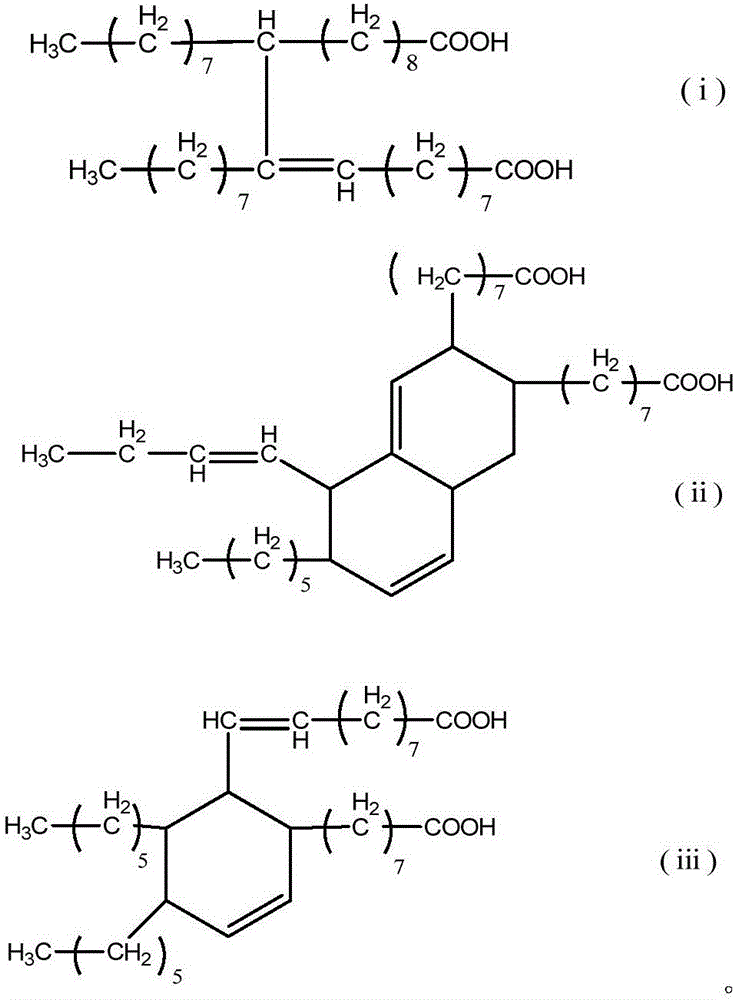Bio-based biodegradable tri-block and multi-block copolymer with dimer acid polyester chain segment, preparation method of copolymer and application of copolymer
A technology of multi-block copolymer and dimer acid polyester, which is applied in the field of bio-based biodegradable tri-block, multi-block copolymer and its preparation, can solve the problem of inability to solve the problem of oil/coal substitution, and achieve good Tensile strength, reduced effect of use
- Summary
- Abstract
- Description
- Claims
- Application Information
AI Technical Summary
Problems solved by technology
Method used
Image
Examples
Embodiment 1
[0052] Step 1: Weigh 0.415 kg of bio-based 2,5-furandicarboxylic acid, 6.0 kg of dimer acid, 3.0 kg of petroleum-based 1,6-hexanediol, 20 grams of malic acid, and 10 grams of tetrabutyl titanate, and add them to In the esterification reaction kettle, the temperature is raised to 200-250° C. in a temperature-programmed manner, and the reaction is stirred for 2-5 hours until the esterification rate reaches more than 97%, and the esterified product (1) is obtained.
[0053] Transfer the esterified product (1) to a polycondensation kettle with a decompression device, evacuate to an absolute pressure of 3-5Kpa while stirring, and raise the temperature to 200-250°C at the same time, stir and react for 1-2 hours, and further reduce the pressure to an absolute pressure 100-200Pa, continue to react for 1-3 hours. The end point of the reaction was judged according to the change of the stirring current. Dimer acid polyester (1) is obtained.
[0054] Step 2: Transfer the dimer acid poly...
Embodiment 2
[0059] The PLA-dimer acid polyester (1)-PLA triblock copolymer (1) prepared in Example 1 is mixed with polybutylene terephthalate adipate in a ratio of 5:5, while adding 2% MDI based on the weight of the polymer, mix evenly, raise the temperature of the internal mixer to 150-200°C in advance, add it to the internal mixer and knead for 30 minutes to obtain PLA-dimer acid polyester (1)-PLA-PBAT Block Copolymer (2).
[0060] The mechanical properties and bio-based content of the obtained multi-block copolymer of table 2 embodiment 2
[0061]
Embodiment 3
[0063] Step 1: Weigh 1.125 kg of bio-based succinic acid, 5.35 kg of dimer acid, 3.5 kg of petroleum-based 1,4-butanediol, 15 grams of bio-based glycerin, and 10 grams of tetraisopropyl titanate, and add them to the esterification In the reaction kettle, the temperature is raised to 160-200°C in a temperature-programmed manner, and the reaction is stirred for 2-5 hours until the esterification rate reaches more than 97%, and the esterified product (2) is obtained.
[0064] Transfer the esterified product (2) to a polycondensation kettle with a decompression device, vacuumize it to an absolute pressure of 3-5Kpa while stirring, and raise the temperature to 200-250°C at the same time, stir and react for 1-2 hours, and further reduce the pressure to an absolute pressure 100-200Pa, continue to react for 1-3 hours. The end point of the reaction was judged according to the change of the stirring current. The dimer acid-containing polyester segment B(2) is obtained.
[0065]Step 2:...
PUM
| Property | Measurement | Unit |
|---|---|---|
| Tensile strength | aaaaa | aaaaa |
| Bending strength | aaaaa | aaaaa |
Abstract
Description
Claims
Application Information
 Login to View More
Login to View More - R&D
- Intellectual Property
- Life Sciences
- Materials
- Tech Scout
- Unparalleled Data Quality
- Higher Quality Content
- 60% Fewer Hallucinations
Browse by: Latest US Patents, China's latest patents, Technical Efficacy Thesaurus, Application Domain, Technology Topic, Popular Technical Reports.
© 2025 PatSnap. All rights reserved.Legal|Privacy policy|Modern Slavery Act Transparency Statement|Sitemap|About US| Contact US: help@patsnap.com



